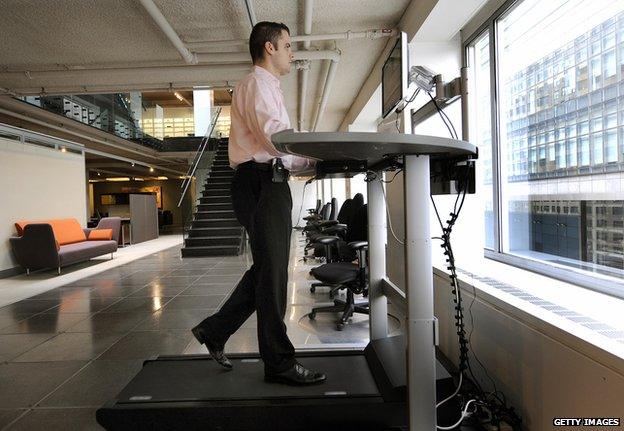Treadmill desks: How practical are they?
- Published

Bombarded with adverts promising a longer, healthier life, BBC News Los Angeles correspondent Peter Bowes goes in search of eternal youth.
Could walking while we work significantly improve our chances of living to a ripe old age? I hope so. As I write, I am walking at 1mph on a treadmill desk.
Many experts believe that there is convincing evidence that sitting all day is killing us. A number of scientific studies have focused on an increasingly sedentary lifestyle as a key reason why people suffer age-related diseases.
"The evidence overwhelmingly suggests that prolonged sitting is shortening our lives, external and also our quality of life," says Dr James Levine, director of obesity solutions at the Mayo Clinic and Arizona State University.
Levine, an endocrinologist, says our computer and gadget-driven society shoulders much of the blame.
"The health consequences of prolonged sitting... include not only obesity but also hypertension, hyperlipidemia - high cholesterol if you like - cardiovascular disease, certain types of cancer, poor or low mood, a predisposition to diabetes," he says.
Peter Bowes tries out a treadmill designed to be used in the office
Putting it bluntly, the overall impact is "early death".
Faced with such a litany of negative consequences, Levine has tested and promoted the concept of a treadmill desk as a way of countering the effects of modern day living.
A number of companies are now manufacturing desks with a modified treadmill base attached to a counter level work surface. The belt is designed to go at a low speed - up to 4mph - with most users opting for 1-2mph.

A normal day in the office for Levine
The average person will burn about 100 calories for every mile that they walk.
Google, Microsoft and Evernote, and the hotel chains Hyatt and Marriott, are among the companies using treadmill desks.
"The interesting thing is that they are putting them in common areas, so that people can use them for an hour then go back to their normal location," says Peter Schenk, president of the exercise equipment company LifeSpan.
Some companies have a check-out system, while other users prefer to have their own dedicated desk, for the entire day.
"We've also had installations in a number of homes where people work and they find themselves very sedentary throughout the day," adds Schenk.
The balance to be struck is between physical benefit and work productivity., external
After jumping on one of the treadmills myself, I found that typing on a computer takes some getting used to, but after a few hours it's second nature. Writing is not so easy.
Teresa Barnes, from Memphis, says she averages 30 to 40 miles (48 to 64 km) per week on her treadmill desk.
"You're seriously multi-tasking," she says. "Every time I walk on this I consider it a gift for me."
Barnes runs a non-profit foundation and spends many hours a week on the telephone.
"We do a lot of conference calls and usually in the beginning of a call I tell them I'm turning my treadmill desk on, and they laugh.
"They get a real kick out if it, sometimes at the end of the phone call I'll tell them how far I've walked," she adds.
Software developer Brian Slick has been using a treadmill desk for over a year and has written a blog about his experience, external.
"I'm not really good about regular exercise such as going to the gym. I needed some way to get exercise while doing work so I don't have to set aside time for it."
Walking up to five hours a day, Slick says he had reduced his waist by 5cm and lost 35lbs (16kgs).

Bowes burnt 300 calories in the writing of this feature
However, he says, the experience "has not all been roses." He has suffered from pain on the bottom of his feet due to inflammation.
"I probably ramped up too quickly and my body didn't adjust all that well. I should have consulted a doctor before starting and worked out some kind of an easing in process," he says.
"But the net result has still been worth it."
Amy Wunsch, a physical therapist, from Newhall in California, says the device is a "fantastic" solution for people suffering the physical issues associated with sitting for extended periods of time.
They include muscle imbalance, flexibility issues and lower back weakness.
But she has a cautionary warning for new users, who may be tempted to shrug over a laptop while walking.
"Make sure that your computer screen is at eye level. The body follows the head, so if your head comes forward the rest of your body is going to slouch forward to go with it. What we want is a really tall posture."
She also warns that walking for a prolonged period of time can lead to overuse injuries.
"It can lead to repetitive strain - especially in the foot and ankle. So if someone's foot and ankle isn't working quite properly that would really exacerbate any injury that could occur there," she says.
But Wunsch's overall assessment is positive. "It's about time," she says.
"We've been in a world that computers and technology have taken over. We have just come and gone with it and made our bodies fit into the electronics instead of making the electronics fit us."
You can follow the Magazine on Twitter, external and on Facebook, external